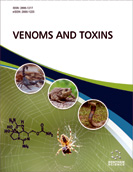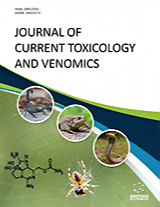Abstract
Venom toxins have specific molecular targets that result in envenomated complications such as neurotoxicity. During evolution, the composition of the venom has been evolved synchronously with the evolution of molecular targets. Venom is an important tool for humans from two different perspectives; venom advantages and disadvantages. Meanwhile, clinical and pharmacological applications of venoms due to their specific targeting and modulation of physiological elements or targets are notable in various disorders. The better understanding of venoms and their composition will improve the practical applications of some toxin-based drugs in drugstoresin the future.
Keywords: Venom-based drugs, venomics, therapeutics, biochemical weapon, genomics, biological molecules.
Graphical Abstract
[http://dx.doi.org/10.1016/j.tree.2012.10.020] [PMID: 23219381]
[http://dx.doi.org/10.4331/wjbc.v6.i2.28] [PMID: 26009701]
[http://dx.doi.org/10.3390/toxins10080306] [PMID: 30042318]
[http://dx.doi.org/10.1016/j.toxicon.2016.11.261] [PMID: 27914888]
[http://dx.doi.org/10.1016/j.toxicon.2016.11.247] [PMID: 27845058]
[http://dx.doi.org/10.1016/j.toxicon.2017.01.012] [PMID: 28192687]
[http://dx.doi.org/10.3390/toxins9090290] [PMID: 28927001]
[http://dx.doi.org/10.1186/1471-2164-11-452] [PMID: 20663230]
[http://dx.doi.org/10.1016/j.toxicon.2008.12.007] [PMID: 19103215]
[http://dx.doi.org/10.1016/j.jprot.2011.11.029] [PMID: 22155128]
[PMID: 26228472]
[http://dx.doi.org/10.1161/01.HYP.17.4.589] [PMID: 2013486]
[http://dx.doi.org/10.1021/pr200876c] [PMID: 22168127]
[http://dx.doi.org/10.4103/jfmpc.jfmpc_208_17] [PMID: 29564263]
[http://dx.doi.org/10.3390/toxins10030126] [PMID: 29547537]
[http://dx.doi.org/10.1152/physrev.00015.2008] [PMID: 19126755]
[http://dx.doi.org/10.4103/0253-7613.150324] [PMID: 25821308]
[http://dx.doi.org/10.1021/mp500393m] [PMID: 25098949]
[http://dx.doi.org/10.1016/j.jmb.2007.02.106] [PMID: 17433819]
[http://dx.doi.org/10.1007/BF02145873] [PMID: 5544731]
[http://dx.doi.org/10.1002/hipo.22191] [PMID: 23966303]
[http://dx.doi.org/10.1371/journal.pntd.0002302] [PMID: 24130909]
[http://dx.doi.org/10.3109/15563650.2014.904046] [PMID: 24708390]
[http://dx.doi.org/10.1074/jbc.M113.464750] [PMID: 23612970]
[http://dx.doi.org/10.1111/echo.12559] [PMID: 24684297]
[http://dx.doi.org/10.1111/jth.12797] [PMID: 25418421]
[http://dx.doi.org/10.1159/000381097] [PMID: 25966620]
[http://dx.doi.org/10.3390/toxins7072413] [PMID: 26131770]
[http://dx.doi.org/10.1002/iid3.76] [PMID: 26734460]
[http://dx.doi.org/10.1016/j.pharmthera.2007.04.004] [PMID: 17555825]
[http://dx.doi.org/10.3390/toxins10090346] [PMID: 30158426]
[http://dx.doi.org/10.18632/oncotarget.21740] [PMID: 29246030]
[http://dx.doi.org/10.3390/toxins7041079] [PMID: 25826056]
[http://dx.doi.org/10.2174/1568026615666150330110822] [PMID: 25858130]
[http://dx.doi.org/10.1038/35040009] [PMID: 11253364]
[http://dx.doi.org/10.4049/jimmunol.1500386] [PMID: 26453752]
[PMID: 25516514]
[http://dx.doi.org/10.1371/journal.pone.0109977] [PMID: 25299676]
[PMID: 26387182]
[http://dx.doi.org/10.1016/j.cbi.2015.04.004] [PMID: 25868679]
[http://dx.doi.org/10.1097/WNR.0000000000000046] [PMID: 24201448]
[http://dx.doi.org/10.1371/journal.pone.0103114] [PMID: 25101679]
[http://dx.doi.org/10.1186/1742-2094-7-69] [PMID: 20950451]
[http://dx.doi.org/10.1007/s12035-014-9012-2] [PMID: 25579380]
[http://dx.doi.org/10.3389/fimmu.2017.01085] [PMID: 28932225]
[http://dx.doi.org/10.1016/j.neuint.2014.11.008] [PMID: 25481089]
[http://dx.doi.org/10.1080/17512433.2016.1183481] [PMID: 27137678]
[http://dx.doi.org/10.3390/md15100313] [PMID: 29027927]
[http://dx.doi.org/10.3390/md12052970] [PMID: 24857959]
[http://dx.doi.org/10.1016/j.toxicon.2004.03.028] [PMID: 15246758]
[http://dx.doi.org/10.2174/0929867043363884] [PMID: 15578997]
[http://dx.doi.org/10.1016/j.pain.2014.06.023] [PMID: 25008370]
[http://dx.doi.org/10.1002/ejp.585] [PMID: 25158907]
[http://dx.doi.org/10.4155/fmc.14.107] [PMID: 25406007]
[http://dx.doi.org/10.1016/j.neuropharm.2014.01.017] [PMID: 24467846]
[http://dx.doi.org/10.1016/j.bbrc.2014.08.051] [PMID: 25148943]
[http://dx.doi.org/10.1016/j.jpain.2014.02.007] [PMID: 24607814]
[http://dx.doi.org/10.1213/ANE.0000000000000249] [PMID: 24836473]
[http://dx.doi.org/10.1016/j.amsu.2014.09.001] [PMID: 25568796]
[http://dx.doi.org/10.1074/jbc.M708447200] [PMID: 18628201]
[http://dx.doi.org/10.1124/mol.115.098178] [PMID: 25979003]
[http://dx.doi.org/10.3390/toxins6082363] [PMID: 25123556]
[http://dx.doi.org/10.1155/2013/369324] [PMID: 24058370]
[http://dx.doi.org/10.1186/1472-6882-14-471] [PMID: 25481535]
[http://dx.doi.org/10.1016/j.jpain.2004.05.003] [PMID: 15336634]
[http://dx.doi.org/10.1016/S2095-4964(15)60178-9] [PMID: 26165368]
[http://dx.doi.org/10.1017/S1461145714000236] [PMID: 24661728]
[http://dx.doi.org/10.1093/neuonc/not221] [PMID: 24305723]
[http://dx.doi.org/10.1016/j.jtbi.2015.02.028] [PMID: 25747777]
[http://dx.doi.org/10.1371/journal.pone.0122840] [PMID: 25822337]
[http://dx.doi.org/10.1016/j.toxicon.2014.04.017] [PMID: 24813333]
[http://dx.doi.org/10.4103/0366-6999.163397] [PMID: 26315082]
[http://dx.doi.org/10.1155/2012/368196] [PMID: 21904562]
[http://dx.doi.org/10.1371/journal.pone.0090576] [PMID: 24594607]
[http://dx.doi.org/10.1172/JCI68295] [PMID: 23728174]
[http://dx.doi.org/10.3233/JPD-140364] [PMID: 24662192]
 30
30 1
1



